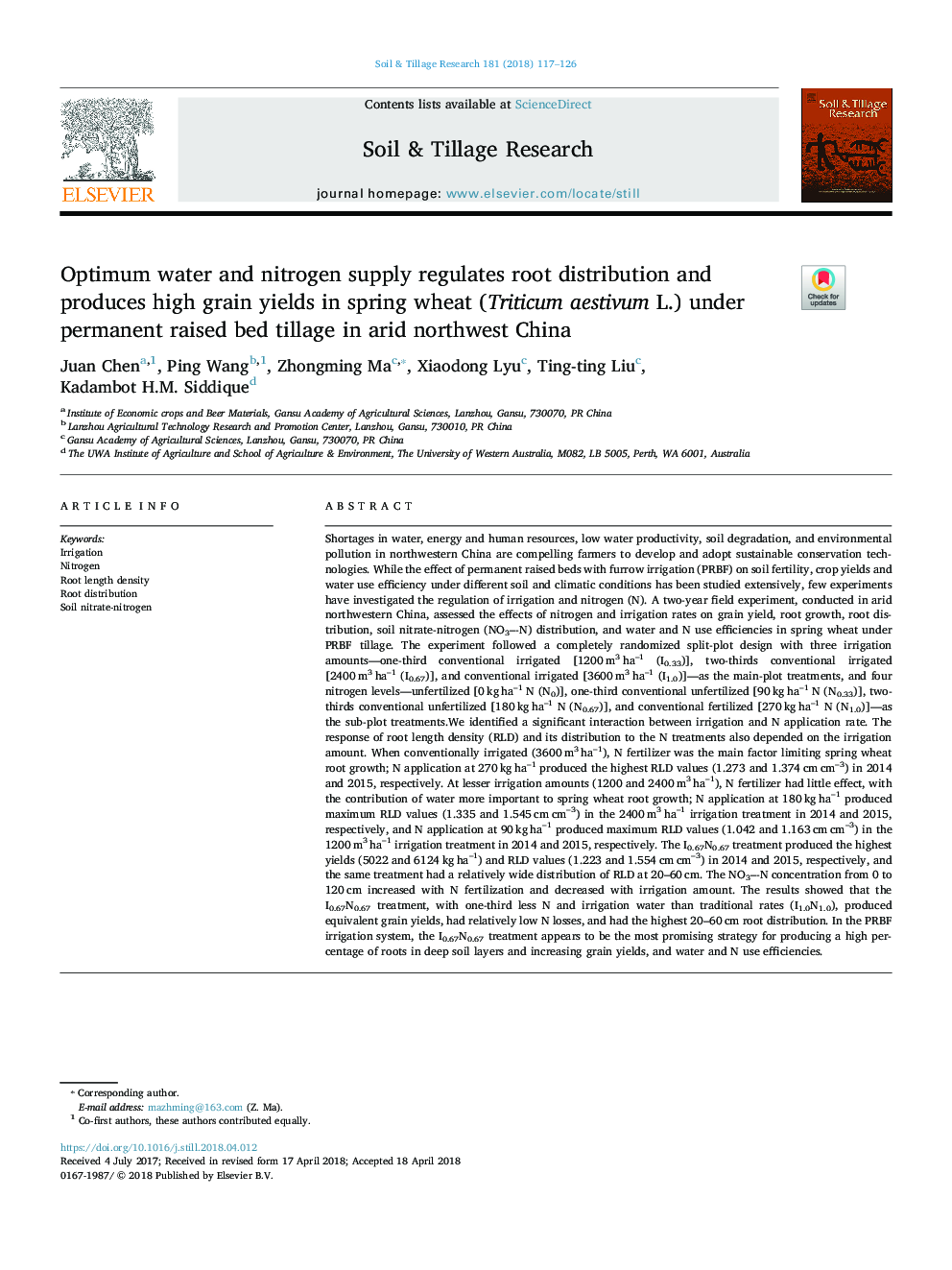| کد مقاله | کد نشریه | سال انتشار | مقاله انگلیسی | نسخه تمام متن |
|---|---|---|---|---|
| 6773024 | 1431822 | 2018 | 10 صفحه PDF | دانلود رایگان |
عنوان انگلیسی مقاله ISI
Optimum water and nitrogen supply regulates root distribution and produces high grain yields in spring wheat (Triticum aestivum L.) under permanent raised bed tillage in arid northwest China
دانلود مقاله + سفارش ترجمه
دانلود مقاله ISI انگلیسی
رایگان برای ایرانیان
کلمات کلیدی
موضوعات مرتبط
مهندسی و علوم پایه
مهندسی انرژی
انرژی های تجدید پذیر، توسعه پایدار و محیط زیست
پیش نمایش صفحه اول مقاله

چکیده انگلیسی
Shortages in water, energy and human resources, low water productivity, soil degradation, and environmental pollution in northwestern China are compelling farmers to develop and adopt sustainable conservation technologies. While the effect of permanent raised beds with furrow irrigation (PRBF) on soil fertility, crop yields and water use efficiency under different soil and climatic conditions has been studied extensively, few experiments have investigated the regulation of irrigation and nitrogen (N). A two-year field experiment, conducted in arid northwestern China, assessed the effects of nitrogen and irrigation rates on grain yield, root growth, root distribution, soil nitrate-nitrogen (NO3--N) distribution, and water and N use efficiencies in spring wheat under PRBF tillage. The experiment followed a completely randomized split-plot design with three irrigation amounts-one-third conventional irrigated [1200â¯m3â¯ha-1 (I0.33)], two-thirds conventional irrigated [2400â¯m3â¯ha-1 (I0.67)], and conventional irrigated [3600â¯m3â¯ha-1 (I1.0)]-as the main-plot treatments, and four nitrogen levels-unfertilized [0â¯kgâ¯ha-1 N (N0)], one-third conventional unfertilized [90â¯kgâ¯ha-1 N (N0.33)], two-thirds conventional unfertilized [180â¯kgâ¯ha-1 N (N0.67)], and conventional fertilized [270â¯kgâ¯ha-1 N (N1.0)]-as the sub-plot treatments.We identified a significant interaction between irrigation and N application rate. The response of root length density (RLD) and its distribution to the N treatments also depended on the irrigation amount. When conventionally irrigated (3600â¯m3â¯ha-1), N fertilizer was the main factor limiting spring wheat root growth; N application at 270â¯kgâ¯ha-1 produced the highest RLD values (1.273 and 1.374â¯cmâ¯cm-3) in 2014 and 2015, respectively. At lesser irrigation amounts (1200 and 2400â¯m3â¯ha-1), N fertilizer had little effect, with the contribution of water more important to spring wheat root growth; N application at 180â¯kgâ¯ha-1 produced maximum RLD values (1.335 and 1.545â¯cmâ¯cm-3) in the 2400â¯m3â¯ha-1 irrigation treatment in 2014 and 2015, respectively, and N application at 90â¯kgâ¯ha-1 produced maximum RLD values (1.042 and 1.163â¯cmâ¯cm-3) in the 1200â¯m3â¯ha-1 irrigation treatment in 2014 and 2015, respectively. The I0.67N0.67 treatment produced the highest yields (5022 and 6124â¯kgâ¯ha-1) and RLD values (1.223 and 1.554â¯cmâ¯cm-3) in 2014 and 2015, respectively, and the same treatment had a relatively wide distribution of RLD at 20-60â¯cm. The NO3--N concentration from 0 to 120â¯cm increased with N fertilization and decreased with irrigation amount. The results showed that the I0.67N0.67 treatment, with one-third less N and irrigation water than traditional rates (I1.0N1.0), produced equivalent grain yields, had relatively low N losses, and had the highest 20-60â¯cm root distribution. In the PRBF irrigation system, the I0.67N0.67 treatment appears to be the most promising strategy for producing a high percentage of roots in deep soil layers and increasing grain yields, and water and N use efficiencies.
ناشر
Database: Elsevier - ScienceDirect (ساینس دایرکت)
Journal: Soil and Tillage Research - Volume 181, September 2018, Pages 117-126
Journal: Soil and Tillage Research - Volume 181, September 2018, Pages 117-126
نویسندگان
Juan Chen, Ping Wang, Zhongming Ma, Xiaodong Lyu, Ting-ting Liu, Kadambot H.M. Siddique,